#MTP Breakout Cable
Explore tagged Tumblr posts
Text

Fiber-Life shares MTP Trunk Cables And MTP Breakout
In high-density network environments such as data centers, MTP trunk cables and MTP breakout cables are two essential types of fiber optic cables.
0 notes
Text
Are you searching a best 12 Fiber Pigtail
A 12-fiber pigtail refers to a fiber optic cable terminated on one end with a connector, typically used for splicing or connecting to other fiber optic cables or devices. In the case of a 12-fiber pigtail, it means that there are 12 individual optical fibers within the cable, each terminated with its connector.

Here are some key points about 12-fiber pigtails:
Number of Fibers: As the name suggests, a 12 fiber pigtail contains 12 individual optical fibers within a single cable assembly. These fibers are typically color-coded for identification purposes.
Connector Type: The connector termination at the end of the pigtail can vary depending on the application and compatibility requirements. Common connector types include LC, SC, ST, and MTP/MPO connectors.
Applications: 12 fiber pigtails are commonly used in data centers, telecommunications networks, and other fiber optic installations where high-density fiber connections are required. They are often used for splicing to distribution or breakout cables, connecting to patch panels, or interfacing with active network equipment.
Splicing: In many cases, the individual fibers within a 12 fiber pigtail are spliced to corresponding fibers in other cables or devices using fusion splicing or mechanical splicing techniques. This allows for the creation of permanent connections between fibers without the need for connectors.
Color Coding: Each fiber within the pigtail may be color-coded to facilitate identification and ensure proper alignment during splicing or connection. Common color codes include blue, orange, green, brown, gray, white, red, black, yellow, violet, rose, and aqua.
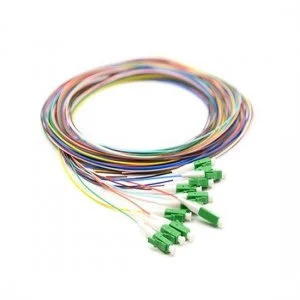
Jacketing and Protection: The fibers within the pigtail are typically enclosed in a protective jacket to provide mechanical protection and prevent damage to the individual fibers. The jacket may be made of materials such as PVC, LSZH (Low Smoke Zero Halogen), or plenum-rated materials for use in different environmental conditions.
Overall, 12 fiber pigtails provide a convenient and efficient solution for establishing multiple fiber connections in various fiber optic applications, offering high-density connectivity and reliable performance in optical networks.
Next: Buy Quality 12 LC Cable for Seamless Connectivity
2 notes
·
View notes
Text
12 LC Fiber Optic Cable – High-Density Singlemode Breakout | Fiber-Mart
Enhance your network with Fiber-Mart’s 12 LC cable, a singlemode breakout solution built for high-density data environments like data centers and enterprise systems. Featuring 12 strands of flat MTP to LC/SC/FC/ST fiber, this cable offers fast, efficient connectivity while reducing signal loss. Its LSZH outer jacket ensures safety and compliance, making it ideal for riser and plenum installations. This cable supports quick deployment and excellent performance in structured cabling systems, where space-saving and high-capacity transmission are critical.
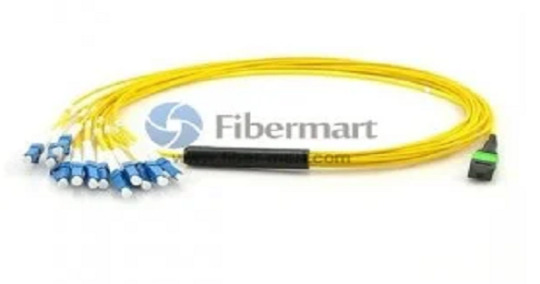
0 notes
Text
FAN OUT CABLES
Understanding Fan-Out Cables: The Essential Connection for Fiber Optic Networks
In the world of fiber optics, ensuring that signals are transmitted efficiently across multiple channels is crucial for modern communication systems. One of the key components used to achieve this is fan-out cables. These specialized cables play an important role in splitting and distributing signals across various endpoints in fiber optic networks. Whether you're setting up a data center, upgrading your broadband infrastructure, or managing a complex telecommunications system, understanding fan-out cables and their uses can help you make the right decisions for your network.
In this blog, we’ll dive into what fan-out cables are, how they work, and why they’re an essential component in fiber optic communication systems.
What is a Fan-Out Cable?
A fan-out cable is a type of fiber optic cable that takes a single high-count fiber optic cable and separates it into multiple individual fibers. Essentially, it “fans out” the individual fibers from a single cable, allowing you to connect multiple devices or endpoints to a single trunk line. This type of cable is designed to help organize and manage fiber connections in complex setups where a single cable needs to be distributed to multiple locations.
Fan-out cables are often used in fiber optic patch panels, distribution frames, or splicing systems, helping reduce clutter, improve organization, and ensure smooth data transmission.
How Do Fan-Out Cables Work?
A typical fiber optic system involves a trunk cable (which can contain many fibers) that runs from a central location (like a switch or a server room) to various endpoints. However, each endpoint needs to be individually connected to the network, which is where fan-out cables come in.
A fan-out cable consists of a buffer tube that holds multiple fibers inside. The cable splits the fibers at the termination point, often converting a high-fiber count (like 12, 24, or more) into individual fibers for easier patching and connection.
Here's how they typically work:
Trunk Cable: A high-count fiber optic cable (like a 12-fiber or 24-fiber cable) comes into the fan-out cable.
Buffer Tubes: The individual fibers inside the trunk cable are grouped together in buffer tubes, which help protect the fibers.
Fan-Out: The cable splits, with each individual fiber being separated out for easier termination, allowing technicians to connect them to patch panels or other equipment as needed.
This “fan-out” effect helps maintain a clean and organized setup while also allowing flexibility in fiber network management.
Types of Fan-Out Cables
There are two primary types of fan-out cables based on their configuration and application:
Standard Fan-Out Cable:
This is a typical fan-out cable used to separate a high-count fiber optic cable into multiple individual fibers. Standard fan-out cables are used in patch panels, distribution frames, and other equipment where individual fibers need to be connected to specific locations.
Breakout Fan-Out Cable:
Breakout fan-out cables have individual fibers that are terminated with connectors (like LC, SC, or MTP connectors). These are often used when a single fiber needs to be quickly connected to network devices like routers, switches, or patch panels without the need for further splicing.
Breakout cables are typically used when you need to connect individual fibers directly to active network equipment, whereas standard fan-out cables are often used in environments where fiber terminations and connections need to be centralized and managed.
Key Benefits of Fan-Out Cables
Fan-out cables are designed to improve the efficiency and organization of fiber optic networks. Here are some of the main benefits of using fan-out cables:
1. Organization and Cleanliness
One of the biggest advantages of fan-out cables is their ability to help maintain a clean and organized network setup. In high-density fiber optic systems, managing large bundles of cables can become a mess without the proper tools. Fan-out cables split a high-count fiber bundle into smaller, more manageable units, allowing for easier identification and termination.
2. Simplified Network Management
By breaking out individual fibers, fan-out cables allow network technicians to easily manage, terminate, and test each fiber separately. This makes maintenance and troubleshooting much more straightforward and allows for a more flexible network infrastructure.
3. Flexible Connections
Fan-out cables provide flexibility in your fiber optic network, allowing multiple devices to connect to a single high-count fiber trunk. Whether you need to connect a few devices or many, fan-out cables make it easier to route signals and ensure high performance across the network.
4. Cost-Effective
While the initial investment in fiber optics can be expensive, fan-out cables help reduce the cost of upgrades and expansions. By allowing a single trunk cable to be split into multiple fibers, you can increase the capacity of your existing fiber optic infrastructure without needing to install new cables for each connection point.
5. Easy to Terminate
Fan-out cables make it much easier to terminate fiber optic connections. Technicians can focus on individual fibers rather than having to deal with a high-count trunk cable, leading to fewer mistakes during installation and faster setup times.
6. Reduced Signal Loss
By keeping the fibers in a manageable and well-organized system, fan-out cables help minimize the risks of signal degradation due to bending, kinks, or poor cable management. Good fiber cable management can maintain the integrity of the signal, ensuring the best possible network performance.
Applications of Fan-Out Cables
Fan-out cables are commonly used in various sectors that rely on fiber optic networks. Some key applications include:
Data Centers
Fan-out cables are used in data centers where large amounts of data need to be transmitted quickly and reliably. These cables help organize fiber connections and improve the efficiency of patching and reconfiguring fiber networks.
Telecommunications
In telecommunications networks, fan-out cables enable the distribution of fiber signals across different locations, ensuring reliable service to both residential and business customers.
Fiber-to-the-Home (FTTH)
FTTH networks use fan-out cables to distribute fiber optic signals from a central node to homes and businesses, providing high-speed internet, television, and phone services.
Campus Networks
Universities, hospitals, and corporate campuses often use fan-out cables to distribute fiber optic connections to multiple buildings or floors, creating a robust and scalable network.
Long-Distance Fiber Optic Networks
Fan-out cables are also employed in long-distance transmission systems, where a single trunk fiber optic cable needs to branch out into multiple separate fibers at various endpoints, such as relay stations or regional hubs.
Conclusion
Fan-out cables are an essential part of modern fiber optic networks, allowing for efficient and flexible distribution of high-bandwidth data across multiple endpoints. Whether you're building a data center, connecting remote locations, or upgrading your telecommunications infrastructure, fan-out cables provide a simple solution for improving cable management, maintaining high signal quality, and simplifying network expansion.
With the growing demand for high-speed internet and data transmission, fan-out cables are more important than ever in ensuring the smooth operation of fiber optic networks. By understanding their role and benefits, you can make better-informed decisions for your network setup, leading to improved performance and long-term scalability.
0 notes
Text
Unveiling the Versatility of MTP Breakout Cable
In the realm of optical communication, the MTP breakout cable emerges as a versatile solution for efficiently connecting high-density MTP/MPO interfaces to individual optical fibers. This innovative cable design enables seamless integration and transmission of multiple optical signals, catering to the diverse needs of modern communication networks. MTP breakout cable, equipped with MTP/MPO…
View On WordPress
0 notes
Video
youtube
✨Add Cable Label for MPO Breakout Patch Cable
More information about the MPO/MTP fiber patch cord can be browsed here🥰 https://holightoptic.com/?s=MPO&lang=en Should any of these products interest you, please let us know. We look forward to hearing from you soon ~
0 notes
Text
https://www.china-tscom.com/products/mpo-harness-cable/
MTP®/MPO harness cables are a kind of MTP®/MPO fanout harness cable or breakout cable assembly with one MTP®/MPO connector on one end and multiple single-fiber connectors (LC, SC, FC, etc.) on the other end, designed for data distribution and routing to patch panels. It is used to transition from trunk backbone assemblies to fiber rack systems. The MTP® harness cable is fully configurable, available with a variety of cable and connector combinations. For the hardware and equipment in the same cabinet, the longer MPO cord can provide flexibility at any location, and the branch MTP®/MPO cable can be winded into the vertical cable organizer.
MTP®/MPO Harness Cable Features
Our MPO/MTP harness cable is with low loss performance.
MPO / MTP in 8/12/16/24/32 fibers interfaces for choices.
This MTP/MPO fanout harness cable is available in OS1, OS2, G.657A2, OM3, OM4 Fiber Grades – OM1 and OM2 available upon request.
Option for LSZH, OFNP or OFNR cable jacket.
100% factory terminated and tested.
Pulling eyes are provided as an option to protect the fiber ends during installation.
Save installation and reconfiguration time.
MTP®/MPO Harness Cord Applications
MPO-LC harness cables are dedicated for direct connection between MPO trunk cables and equipment with SFP+ ports via an MPO adapter. Available in polarity A, B or C, these MPO-LC harness cables as well enable connection to SFP+ ports in adjacent racks.
MPO-LC harness cables are compatible with all other MPO module cassette-based systems without any loss of optical performance.
MPO-LC harness cable is typically constructed with a mini cable that features by small diameter, low weight, and low bend radius. In a typical scenario, it’s used to make connections within the same rack or go-between adjacent racks via overhead cabling trays, slots or open ducting systems.
Data Center Interconnect
High-Density Fiber Management
Telecommunication Networks and CATV networks
LAN/WAN Premises
Standards Compliance of MTP®/MPO Harness Cable
TIA/EIA-568.3-D and ISO/IEC 11801;
IEC-61754 & EIA/TIA-604-5;
NFPA 262 or IEC 60332;
EN 50575;
Our MPO/MTP harness cable complies with GR-1435-CORE, GR-2866-CORE, GR-326-CORE;
Our 100g harness cable is compliant to Directive 2002/95/EC (RoHS) and REACH SvHC.
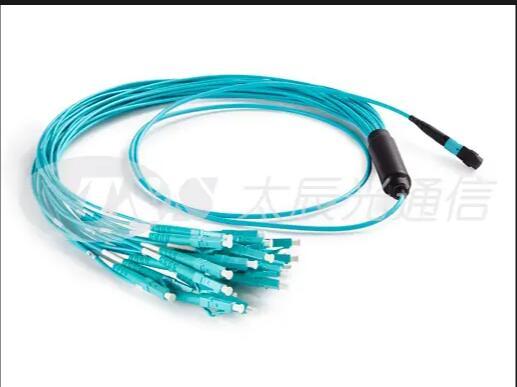
1 note
·
View note
Text
MTP/MPO Fiber Optic Cable: Types and Their Applications
With ever-greater bandwidths and network connections to deal with in data centers, traditional duplex fiber patch cords like LC fiber patch cords no longer meet the demands. To solve this issue, MTP/MPO fiber optic cable that houses more fibers in a multi-fiber MTP/MPO connector was introduced in the market as a practical solution for 40G/100G/400G high-density cabling in data centers. This article will introduce different MTP/MPO cable types and their applications.
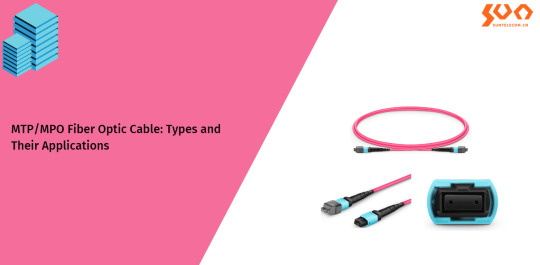
What is MTP/MPO Cable?
MPO (multi-fiber push-on) is the first generation of clip-clamping multi-core fiber optic connectors. MTP is an advanced version of MPO with the better mechanical and optical performance. They look similar and are fully compatible and interchangeable.

MTP/MPO cable consists of MTP/MPO connector and optical fiber. MTP/MPO connector has a female type (without pins) or a male type (with pins). MTP/MPO connector increases the fiber optic cable density and saves circuit card and rack space, which is well suited for current data center cabling and future network speed upgrades.
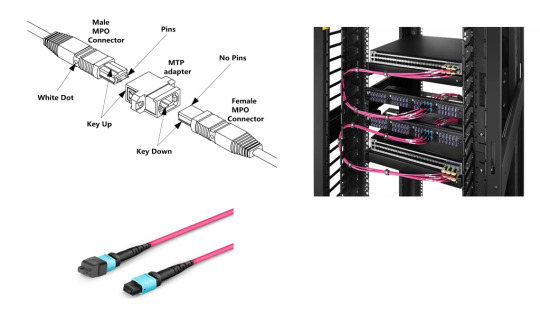
MTP/MPO Cable Types
MTP/MPO cable types are classified based on function, polarity, fiber count, fiber mode, and jacket rating.
By Function
Based on function, MPO/MTP cable type is divided into MTP/MPO trunk cable, MTP/MPO breakout cable, and MTP/MPO conversion cable.
MTP/MPO Trunk Cable
MTP/MPO trunk cable is terminated with an MTP/MPO connector (female/male) on both ends, which is available in 8-144 fiber counts for users’ choices. Typically, MTP/MPO trunk cable is ideal for creating a structured cabling system, including backbone and horizontal interconnections such as 40G-40G and 100G-100G direct connections.

2.MTP/MPO Breakout Cable
MTP/MPO breakout cable (aka. harness cable or fanout cable) is terminated with a female/male MTP/MPO connector on one end and 4/6/8/12 duplex LC/FC/SC/ST connectors on the other end, such as 8-fiber MTP/MPO to 4 LC harness cables and 12-fiber MTP/MPO to 6 LC harness cables. Typically, MTP/MPO breakout cable is ideal for short-range 10G-40G and 25G-100G direct connections or for connecting backbone assemblies to a rack system in the high-density backbone cabling.

3.MTP/MPO Conversion Cable
MTP/MPO conversion cable has the same fanout design as MTP/MPO breakout cable but is different in fiber counts and types. MTP/MPO conversion cable is terminated with MTP/MPO connectors on both ends. MTP/MPO conversion cable is available in 24-fiber to 2×12-fiber, 24-fiber to 3×8-fiber, and 2×12-fiber to 3×8-fiber types, and is ideal for 10G-40G, 40G-40G, 40G-100G, and 40G-120G connections, which eliminate fiber wasting and largely increase the flexibility of the MTP/MPO cabling system.
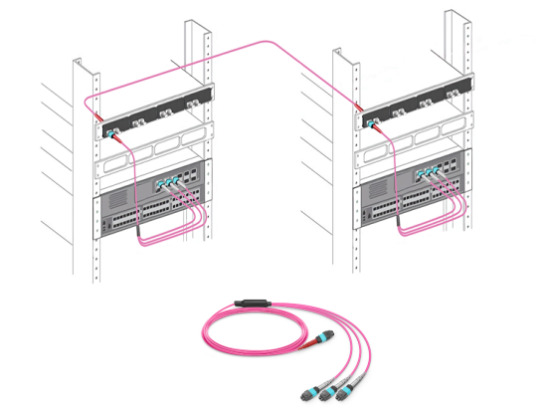
By Polarity
Polarity refers to the difference between the optical transmitters and receivers at both ends of the fiber link. Due to the special design of MTP/MPO connectors, polarity issues must be addressed in high-density MTP/MPO cabling systems. To guarantee the correct polarity of the optical path, the TIA 568 standard defines three connection methods, called Type A, Type B, and Type C. The cables of the three MTP/MPO connector types have different structures.
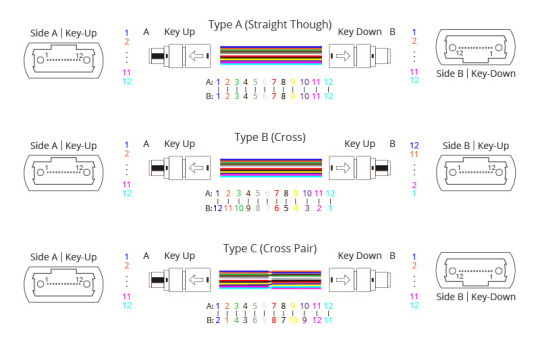
By Fiber Count
Based on fiber count, MTP/MPO cable type is divided into 8/12/16/24 fiber. The 8-fiber MTP/MPO cable can transmit the same data rate as 12-fiber, but with lower cost and insertion loss, making it a more cost-effective solution. 12-fiber MTP/MPO cable is the earliest developed and most commonly used solution in 10G-40G and 40G-100G connections. If it is used in 40G QSFP+ or 100G QSFP28 transceivers, 4 fibers will be idle, resulting in low fiber utilization.16-fiber MTP/MPO is designed for 800G QSFP-DD/OSFP DR8 and 800G OSFP XDR8 optics direct connection and supporting 800G transmission for hyperscale data center. 24-fiber fiber MTP/MPO cable is used to establish a 100GBASE-SR10 connection or 400G connection between CFP and CFP transceivers.

By Fiber Mode
Based on fiber mode, MTP/MPO cable includes single-mode (SM) and multi-mode (MM). SM MTP/MPO cable is suitable for long-distance transmissions, such as in metropolitan area networks (MANs) and passive optical networks PONs (PONs), with less modal dispersion, and it is available in OS2 type. While MM MTP/MPO cable is suitable for short-distance transmission, allowing 40 Git/s maximum transmission distance of 100m or 150m, and it is available in OM3/OM4 types.

By Jacket Rating
According to different fire rating requirements, the jackets of MTP/MPO cable types are divided into low smoke zero halogen (LSZH), optical fiber non-conductive plenum (OFNP), communications multipurpose cable plenum (CMP), etc. LSZH MTP/MPO cable is free of halogenated materials (toxic and corrosive during combustion), provides better protection for personnel and equipment in a fire, and is suitable for closed places. OFNP MTP/MPO cable contains no electrically conductive elements and is designed with the highest fire rating, which can be installed in ducts, plenums, and other spaces for building airflow. CMP MTP/MPO cable can restrict flame propagation and smoke exhaust rate during a fire, which is suitable for plenum spaces, where air circulation for heating and air conditioning systems are facilitated.
Conclusion
MTP/MPO cables provide stable transmission, high performance, high-density cabling for various environments, and prevent network bottlenecks, reduce network latency, and expand bandwidth and scalability for future network expansion. Sun Telecom provides total and customized solutions of fiber optic products to the global market. Contact us if you have any needs.
2 notes
·
View notes
Text
Guidelines to choose Right Fiber Patch Cord Types
There are numerous fiber patch cord types, such as OM1, OM2, OM3, OM4 multimode fiber, and OS2 single-mode fiber types. Both elements of the cable are ended with a superior hybrid or single type connector including an SC, ST, FC, LC, MTRJ, E2000 connector in simplex and duplex. These are commonly not ruggedized, contingent upon the application, making them reasonable for inward use. How to pick right fiber patch cord types for your network? Simply pursue these guidelines.
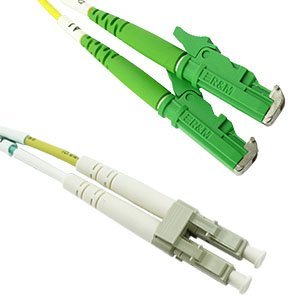
Choose the Right Connector Type (LC/SC/ST/FC/MPO/MTP)
On both ends of the fiber optic patch cord are ended with a fiber optic connector (LC/SC/ST/FC/MPO/ MTP breakout kabel). The distinctive connector is utilized to connect to various gadgets. If ports in the two finishes gadgets are the equivalent, we can utilize, for example, LC-LC/SC-SC/MPO-MPO patch cables. If you need to interface various ports type gadgets, LC-SC/LC-ST/LC-FC patch cables may suit you.
Choose Single-mode or Multimode Cable Type?
Single-mode fiber patch cord utilizes 9/125um glass fiber, LC SC multimode glasfaser patchkabel fiber patch cord utilizes 50/125um or 62.5/125um glass fiber. Single-mode fiber optic patch cord is utilized in long separation information transmission. The multimode fiber optic patch cord is using in short-distance transmission. Run of the mill single-mode fiber optic patch cord utilized yellow fiber cable and multimode fiber optic patch cord utilized orange or aqua fiber link.
Fiber Patch Cord Types – opt for Simplex or Duplex?
Simplex implies this fiber patch cable is with one cord, at each end is just a single fiber connector, which is utilized for Bidirectional (BIDI) fiber optic transceiver. Duplex can be viewed as two fiber patch cable put next to each other, which is utilized for basic handsets.
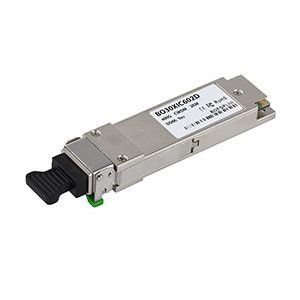
Choose the Right Cable Length (1m/5m/10m/20m/30m/50m)
Fiber optic patch cables are made in various lengths, as a rule from 0.5m to 50m. You ought to pick a fitting link length as indicated by the separation between the gadgets you need to interface.
Choose the Right Connector Polish Type (UPC/APC)
Since the loss of the APC connector is lower than UPC connectors, generally, the optical exhibition of APC connectors is superior to UPC connectors. In the present market, the APC connectors are broadly utilized in applications, for example, FTTx, passive optical system (PON) and wavelength-division multiplexing (WDM) that are progressively touchy to return misfortune. But APC connector is generally costly than the UPC connector, so you ought to gauge the advantages and disadvantages. With those applications that call for high exactness optical fiber flagging, APC ought to be the principal thought, yet less delicate digital systems will perform similarly well utilizing UPC. For the most part, the connector shade of APC patch cable is green, and of UPC patch cable is blue.
Choose the Right Cable Jacket Type (PVC/LSZH/OFNP)
Usually, there are three cable coat types: Polyvinyl Chloride (PVC), Low Smoke Zero Halogen (LSZH) and Optical Fiber Nonconductive Plenum (OFNP).
REFERENCES:
https://diigo.com/0fwajq
http://ttlink.com/gbicshopde
https://www.evernote.com/shard/s411/sh/e668ef3b-f7ee-428e-8953-3dd6587c018d/ca01d4a8096d0d9d0e959219bbb0f27c
https://list.ly/list/3ZLE-get-qsfp28-direct-attach-cables-with-superior-quality?make_list_mode=true
https://justpaste.it/2ek6y
http://tbf.me/a/Bcf8kc
https://in.pinterest.com/pin/759208449668365552
#BlueOptics Transceiver#MTP Breakout Kabel#Direct Attach Kabel#Direct Attach Cables#QSFP28 Direct Attach Cables#LC Uniboot Multimode Glasfaser Patchkabel
0 notes
Text
Overview of MPO/MTP Cabling Solutions for 40G And 100G Ethernet
With the development of network technology, the demand for high-speed data transmission and data capacity is becoming much greater than ever before. As many data centers are in the process of 10G to 40G and 100G migration, the optical components applied in the cabling system have to be upgraded to meet the requirements. MPO/MTP cabling solutions are gradually popular among data center managers, since they can provide fast installation, high density and high performance cabling for data centers. This article is going to focus on some components used in MPO/MTP cabling solutions and advantages of MPO/MTP cabling solutions.
Components Used in MPO/MTP Cabling Solutions
MPO/MTP Connector
MPO (multi-fiber push on) connector is a multi-fiber connector which is most commonly defined by two documents: one is IEC-61754-7, the commonly sited standard for MPO connectors internationally; the other one is EIA/TIA-604-5, also known as FOCIS 5, the most common standard sited for in the US. Based on MT ferrule, MPO connector is designed to to enable multi-fiber connectivity for higher density, higher bandwidth based applications. MTP (multi-fiber termination push on) connector is a high performance MPO connector with multiple engineered product enhancements to improve optical and mechanical performance when compared to generic MPO connector. In addition, MTP connector is in complete compliance with all MPO connector standards. Here shows a picture of MPO/MTP connector for you.
MPO/MTP Trunk Cable
MPO/MTP trunk cable, terminated with MPO/MTP connectors at both ends, is available with 12, 24, 48, and 72 fibers. It can create the permanent fiber links between panels in a structured environment. And it is typically used as backbone or horizontal cable interconnections. With efficient plug and play architecture, MPO/MTP trunk cable can greatly reduce the installation and maintenance costs. Here is a figure of MPO/MTP trunk cables for you.
MPO/MTP Harness Cable
MPO/MTP harness cable, also named MTP/MPO fanout cable or MPO/MTP breakout cable, is terminated with a male/female MTP connector on one side and several duplex LC/SC connectors on the other side, providing a transmission from multi-fiber cables to individual fibers or duplex connectors. It is typically used to connect equipment in racks to MPO/MTP terminated backbone cables. MPO/MTP harness cable is designed for high density applications which require high performance and speedy installation without on-site termination. From the figure below, you can have a deep understanding of the structure of MPO/MTP harness cable.
MPO/MTP Cassette
MPO/MTP cassette is a modular module, which enables users to take the fibers brought by a trunk cable and distribute them to a duplex cable. Loaded with 12 or 24 fibers, LC or SC adapters on the front side and MPO/MTP at the rear, MPO/MTP cassette serves to transition ribbon cables terminated with MPO/MTP connector to the more common LC or SC interface used on the transceiver terminal equipment. This kind of cassette provides a quick and efficient way to deploy up to 24 LC or 12 SC fiber ports in a single module. To better understand the inner structure of MPO/MTP cassette, here is a figure for you.
Advantages of MPO/MTP Cabling Solutions
First, designed with a simple push-pull latching mechanism, MPO/MTP products can realize easy and intuitive insertion and removal. Second, with the same size as a SC connector, the MPO/MTP connector can accommodate 12/24 fibers, which provides 12/24 times the density and greatly saves the rack space. Third, as the installation process of MPO/MTP products is simple and easy, the installation time involving a costly highly qualified workforce can be reduced to a minimum. Fourth, most MPO/MTP products are modular solutions, which can be a good choice to ease future expansion and for quick and easy system reconfiguration.
Conclusion
With the advent and popularity of cloud computing and big data, 40G and 100G Ethernet is now a trend and hotspot for data center cabling system. Since MPO/MTP connectors are the up-and-coming standard optical interface for 40G and 100G Ethernet network, it is predicted that MPO/MTP cabling solutions will eventually flood the data center. After all, the high fiber count in one connector creates endless possibilities.
0 notes
Text

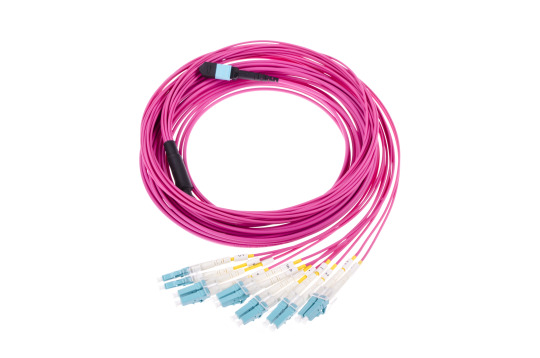


MPO to LC UPC 6 Duplex OM4 12Fibers Breakout Fiber Patch Cable
www.holightoptic.com / [email protected]
#MPO#cable#ftth#telecom#networking#MTP#optical#OM4#patchcords#fibreoptique#datacenters#5Gnetwork#networkingcables#fiberinstallation#holight#fiberoptic#fiberoptics#communication#datacenter#cloud#telecom#ftth#networks#patchcord#telecommunication#fttx#telecommunication
0 notes
Text
MPO Trunk Cable-Its Polarity and Types
Today the use of MTP MPO Cables has increased tremendously. MTP trunk cable is often said an enhanced MPO cable version. MTP connector consists of a removable housing that permits polishing, re-working, and changing of connector heads. To make sure that the cable is not easily broken inside the connector housing it has a more advanced mechanical support system.
However, there are many MPO who from the extensive bending force has implemented the same type of mechanical support and provide breaking resistance, but it never guarantees a removable housing.

MPO trunk cable /MTP technology has some properties like high density, flexibility, and reliability with scalable, upgradeable properties. It ensures that to receive the port of the second piece of active equipment, a transmit signal from any type of active equipment will be directed across a fiber network if the right polarity is maintained.
Three Types of Cables for Three Polarization Methods
MPO Trunk Cable Type A: Type A cable also referred to as straight cable consists of a key up MPO connector on one end and the opposite end a key down MPO connector. The same fiber position can be maintained through these fibers at each end of the cable.
MPO Trunk Cable Type B: On both ends of the cable Type B cable make use of a key-up connector. Inversion happens through his type of array mating, which indicates that at each end the fiber positions are reversed.
MPO Trunk Cable Type C: Having one key up and one key down connector on every side, the Type C cable looks similar to Type-A cable. But, in Type C at one end each adjacent pair of fibers are flipped at the other end.

Conclusion
Network designers make use of MPO/ MTP trunk cable components so that they can satisfy the increasing requirement for higher transmission speed. By doing this one of the big issues that are polarity is solved. MTP connector consists of a removable housing that permits polishing, re-working, and changing of connector heads. However, it also needs a selection of the right types of MPO cassette, MPO cables, MPO connectors, and patch cables.
Main souce: https://fibermart.blogspot.com/
2 notes
·
View notes
Text
12 LC Singlemode MTP Breakout Fiber Cables – Fiber-Mart
Upgrade your fiber connectivity with our premium 12 LC cable solutions at Fiber-Mart. This singlemode MTP breakout cable features 12 strands and is designed for high-density, high-performance network environments. Ideal for data centers, enterprise backbones, and telecom setups, the LC cable offers low insertion loss, superior durability, and easy management. Compatible with standard connectors, it ensures seamless integration and high-speed data transmission. Choose this breakout cable to streamline your cabling system with reliability and precision.
0 notes
Text
12F OptiTap MPO/MTP to 12x SC APC breakout cables. Excellent design for outdoor OSP projects and 100% compatible with Corning OptiTap connectotors, PM me or whatsapp +8618813926110 for more informations.
0 notes
Text
QSFP28 and QSFP+ cabling solution .
LC Duplex Patch Cables
Single-mode patch cables with LC duplex connectors are often wont to connect two transceivers of an equivalent type—40GBASE-LR4-to-40GBASE-LR4 or 100GBASE-LR4-to100GBASE-LR4. The SMF patch cable is one fiber pair with two LC duplex connectors at opposite ends.
The long range QSFP+ and 100G QSFP28 transceiver use single-mode fiber patch cables with duplex LC connectors. This text may introduce the cabling solutions for QSFP+ and QSFP28 transceiver to you.
· Single-mode LC duplex patch cable
· 40GBASE-LR4 QSFP+ 10km, 40GBASE-ER4 QSFP+ 40km, 100GBASE-LR4 QSFP28 10km
12-Fiber Patch Cables with MTP Connectors
12-fiber patch cables with MTP connectors are often wont to connect two transceivers of an equivalent type—40GBASE-SR4-to-40GBASESR4 or 100GBASE-SR4-to-100GBASE-SR4. You'll also connect 4x10GBASE-LR transceivers like 40GBASE-PLRL4 and 40GBASE-PLR4 using patch cables—4x10GBASE-LR-to-4x10GBASE-LR—instead of breaking the signal out into four separate signals. Make sure that you order cables with the right polarity. The MTP connectors on the 12-fiber cables should be key up (sometimes mentioned as latch up, Type B, or Method B). If you're using patch panels between two QSFP+ or QSFP28 transceivers, make sure that the right polarity is maintained through the cable plant.
· Multimode OM3 12-fiber MTP patch cable
· 40GBASE-SR4 QSFP+ 100m, 100GBASE-SR4 QSFP28 70m
· Multimode OM4 12-fiber MTP patch cable
· 40GBASE-SR4 QSFP+ 150m, 100GBASE-SR4 QSFP28 100m
· Single-mode 12-fiber MTP patch cable
· 40GBASE-PLRL4 QSFP+ 1km, 40GBASE-PLR4 QSFP+ 2km
12-Fiber Breakout Cables with MTP-LC Duplex Connectors
12-fiber breakout cables with MTP-LC duplex connectors are often wont to connect a 4x10GBASE-LR or 4x10GBASE-SR transceiver to four separate 10GBASE-LR or 10GBASE-SR SFP+ transceivers. The breakout cable is made from a 12-ribbon fiber-optic cable. The breakout cable splits from one cable with an MTP connector on one end, into 4 cable pairs with 4 LC duplex connectors on the other end.
· Multimode OM3 12-fiber MTP-LC breakout cable
· 40GBASE-SR4 QSFP+ 100m, 100GBASE-SR4 QSFP28 70m
· Multimode OM4 12-fiber MTP-LC breakout cable
· 40GBASE-SR4 QSFP+ 150m, 100GBASE-SR4 QSFP28 100m
· Single-mode 12-fiber MTP-LC breakout cable
· 40GBASE-PLRL4 QSFP+ 1km, 40GBASE-PLR4 QSFP+ 2km
About Flypro.comFLYPRO.com is the leadership of fiber optics direct sales store, including optical modules , fiber optic cables and fiber optic transceivers for Datacenters, Enterprise Network company in USA and Europe.
0 notes
Text
Unveiling the Versatility of MTP Breakout Cable
In the realm of optical communication, the MTP breakout cable emerges as a versatile solution for efficiently connecting high-density MTP/MPO interfaces to individual optical fibers. This innovative cable design enables seamless integration and transmission of multiple optical signals, catering to the diverse needs of modern communication networks. MTP breakout cable, equipped with MTP/MPO…
View On WordPress
0 notes